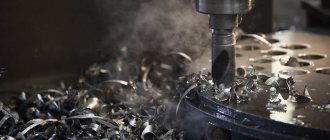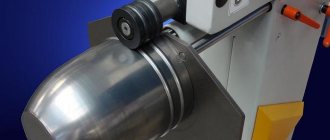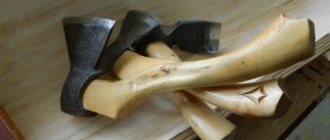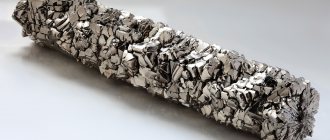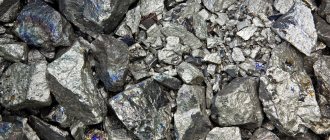Homogenization annealing of aluminum
Ingots are subjected to this type of annealing before pressure treatment to eliminate dendritic segregation, which leads to the formation of a heterogeneous solid solution and the precipitation of brittle nonequilibrium eutectic inclusions CuAl2, Mg2Si, Al2CuMg (S-phase), Al6CuMg4 (T-phase) along grain boundaries and between the branches of dendrites. phase), etc. In the process of homogenization, the composition of solid solution crystallites is leveled, and intermetallic compounds are dissolved. During subsequent cooling, intermetallic compounds are released in the form of evenly distributed small secondary inclusions (Fig. 159, b). As a result, the ductility of the cast alloy increases, which makes it possible to increase the degree of compression during hot forming, the pressing speed and reduce technological waste. Homogenization promotes a fine grain structure in the annealed sheets and reduces the susceptibility to stress corrosion. The homogenization temperature lies slightly below the nonequilibrium solidus and for the most common alloys is 480–530°C. The exposure ranges from 6 to 36 hours. Cooling is carried out in air or together with a furnace.
Types of flux
The connection of two materials is obtained if a certain temperature is maintained in the seam area. For different materials, this indicator varies from 50ºС to 500ºС and above. The melting temperature of the solder must be significantly higher than the melting temperature of the material being processed.
There are different types of fluxes for soldering; the choice depends on the type of metal and soldering temperature.
The choice of flux depends on the following parameters:
- materials to be joined;
- melting temperatures of the part and flux;
- surface dimensions;
- strength and corrosion resistance.
Fluxes are divided into two groups: hard with a high temperature threshold and soft with a low melting point.
Refractory solders have a melting point of more than 500ºC and create a very strong connection. The disadvantage of these solders is that their high melting point sometimes leads to undesirable consequences: overheating of the main part and rendering it unusable.
Low-melting solders have a melting point from 50 ºС to 400 ºС. Their composition is dominated by 38% tin, 61% lead and 1% other impurities. This type of flux is used by radio technicians for installation work.
There is a group of so-called ultra-low-melting solders. They are used to connect transistors. The melting temperature of such fluxes does not exceed 150ºС.
For soldering thin surfaces, soft solders are used, and for large-diameter wires, hard solders with a high temperature threshold are required.
The flux must meet the following characteristics:
Characteristics of fluxes for soldering.
- conduct current and heat well;
- strength;
- high stretch coefficient;
- resistance to corrosion;
- the difference between the melting temperatures of the solder and the base metal.
Solders come in the form of rods, strips, coils of wire, tubes filled with rosin or other flux.
The most common form of solder is a tin rod with a cross-sectional diameter of 1 to 5 m.
There are also multi-channel fluxes that have multiple sources of solder for a strong connection. Such solders are sold in coils, in flasks, coiled, in reels. For one-time use, it is recommended to purchase a small pile of wire, the size of a match.
For soldering electrical circuits, fluxes in the form of tubes filled with colophonium are used. This resin acts as solder. This filler material is used to join copper, brass, and silver.
Return to contents
Recrystallization annealing of aluminum
Recrystallization annealing involves heating a deformed alloy to temperatures above the temperature at which the primary recrystallization ends; it is used to remove hardening and obtain fine grains. For most aluminum alloys, at a degree of deformation of 50–70%, the temperature of the onset of recrystallization is in the range of 280–300°C. The temperature of recrystallization annealing, depending on the composition of the alloy, ranges from 300 to 500 °C (high annealing), with a holding time of 0.5–3.0 hours. After recrystallization annealing of alloys that cannot be strengthened by heat treatment, the cooling rate is chosen arbitrarily. For alloys hardened by heat treatment, the cooling rate to 200–250°C should be
30°C/h. Annealing is used as an intermediate operation between hot and cold deformation. A type of recrystallization annealing is incomplete annealing (low annealing), which allows you to obtain intermediate properties - between the cold-worked state and the recrystallized state. In this case, the annealing temperature must be lower than the temperature at which recrystallization ends to obtain a polygonized structure or a partially recrystallized one, when the hardening is partially removed (annealing temperature 150–300°C). Incomplete annealing is more often used for deformed alloys that cannot be strengthened by hardening and aging.
Annealing of aluminum for softening of aluminum alloys
Annealing to soften the alloys (full annealing) is carried out at 350-430°C with a holding time of 1-2 hours. At these temperatures, complete decomposition of the supersaturated solid solution and coagulation of strengthening phases occurs. To avoid hardening, the cooling rate should not exceed 30°C/h. After annealing, the alloy has low tensile strength values, satisfactory ductility and high resistance to stress corrosion. The annealed material is capable of withstanding cold working with high degrees of deformation.
Aluminum - properties of aluminum, GOSTs, rolled aluminum.
Hardening of aluminum castings
Hardening is not suitable for all types of aluminum alloys. For a successful structural change, the alloy must contain components such as copper, magnesium, zinc, silicon or lithium. It is these substances that are able to completely dissolve in the composition of aluminum, creating a structure that has properties different from aluminum.
This type of heat treatment is carried out under intense heating, allowing the constituent elements to dissolve in the alloy, with further intensive cooling to their normal state.
Thermal transformations in alloys 6060, 6063, AD31
When choosing a temperature regime, you should focus on the amount of copper. Also, you need to take into account the properties of cast products.
In industrial conditions, the heating temperature for hardening ranges from 450 to 560 degrees. Holding products at this temperature ensures the melting of the components in the composition. The holding time depends on the type of product; for deformed ones it usually does not exceed more than an hour, and for cast ones - from several hours to two days.
The cooling rate during hardening must be selected so that the composition of the aluminum alloy is not subject to decomposition. In industrial production, cooling is carried out using water. However, this method is not always optimal, since when thick products are cooled, an uneven temperature decrease occurs in the center and along the edges of the product. Therefore, for large and complex products, other cooling methods are used, which are selected individually.
Heat treatment of aluminum and magnesium alloys.
Heat treatment of aluminum and magnesium alloys is a critical operation of the technological process. Its purpose is to change the structure and physical and chemical properties of alloys. The heat treatment mode is selected depending on the alloys and the method of manufacturing blanks and parts from them.
Heat treatment of parts made from aluminum alloys is based on the fact that with decreasing temperature the solubility of many elements in solid aluminum decreases. When heated for quenching, aluminum alloys do not completely crystallize. If the alloy is overheated, resulting in a structure with large grains, then such an alloy is rejected. Therefore, the thermist must be attentive to the heating of parts made of aluminum alloys.
Heat treatment of deformable aluminum alloys. Deformable aluminum alloys are subjected to such types of heat treatment as annealing, hardening, and aging.
Heat treatment of aluminum alloys: types and modes – Turner
18.12.2019
Heat treatment of aluminum profiles is used to modify the properties of the aluminum alloys from which they are made by changing their microstructure.
The main strengthening mechanisms in aluminum alloys are strengthening due to solid solution alloying and strengthening due to precipitation of secondary phases.
As a rule, one of these mechanisms is dominant in the alloy.
Solid solution of aluminum alloys
A solid solution is obtained by heating an aluminum alloy, during which all phases present in it dissolve to form one homogeneous phase - aluminum with alloying elements dissolved in it. With increasing temperature, the solubility of elements increases, and with decreasing temperature, it decreases.
The mechanism of hardening is that when the aluminum alloy is cooled quickly enough, the dissolved elements remain in the atomic lattice of aluminum and distort and elastically deform it.
This distorted atomic lattice hinders the movement of dislocations and, consequently, plastic deformation of the alloy and thereby increases its mechanical strength.
Aging of aluminum alloys
Aluminum alloys that are hardened by age contain a certain amount of soluble alloying elements, such as some combinations of copper, magnesium, silicon, manganese and zinc.
When subjected to appropriate heat treatment, these dissolved atoms combine into very small particles that are released within the grains of the aluminum alloy. This process is called aging, as it occurs “by itself” at room temperature.
To speed up and achieve greater efficiency in strengthening the aluminum alloy, aging is carried out at elevated temperatures, say 200 °C.
Hardening of aluminum profiles on a press
Press hardening is a very cost-effective technology for heat treatment of aluminum profiles compared to hardening with separate heating. When hardening in a press, aluminum profiles are cooled based on the temperature at which they leave the matrix.
A necessary condition for hardening on a press is that the heating temperature range of the aluminum alloy for hardening must coincide with the temperature range of aluminum profiles at the outlet of the press.
This, in principle, is carried out only for “soft” and “semi-hard” aluminum alloys - technical aluminum, aluminum alloys of the 3xxx and 6xxx series, as well as low-alloy alloys of the 5xxx series (with magnesium up to 3%) and some aluminum alloys of the 7xxx series without copper alloying (7020, 7005 (our 1915), 7003).
The hardening effect for 3xxx and 5xxx aluminum alloys is very small and, as a rule, is not taken into account.
The final mechanical properties of aluminum alloys 3xxx and 5xxx are obtained not as a result of thermal hardening, but during subsequent cold hardening, which may include heat treatment operations: one or more annealing. The strengthening phase for alloys of the 6xxx series is the Mg2Si compound. For more details, see Hardening aluminum profiles on a press
Press hardening of alloys AD31, 6060 and 6063
All aluminum alloys of the 6xxx series can be hardened directly on the press. To fix the dissolved phases in the aluminum solid solution, it is necessary to cool the aluminum profiles at the outlet of the press at a speed not lower than a certain critical speed.
This speed depends on the chemical composition of the aluminum alloy. Typically, enhanced cooling by fans is sufficient for most aluminum profiles, but sometimes it is necessary to cool them with water or a mixture of air and water.
Successful hardening of 6xxx series aluminum alloys depends on the thickness of the profile, as well as the type of alloy and its chemical composition.
In the case of overly massive aluminum profiles, for example, from alloy AD33 (6061) and a relatively slow pressing speed, the material exiting the matrix may not reach the temperature range required for hardening and some of the Mg2Si particles will remain undissolved.
Therefore, with subsequent air, or even water, cooling of the profiles, their complete hardening will not be possible. In such cases, separate heating is used for hardening in special furnaces - usually vertical, followed by cooling in vertical tanks with water. After hardening, aluminum profiles are stretched by 1.5 - 3% to straighten and relieve residual stresses.
Aging of aluminum profiles: artificial and natural
The final operation of heat treatment of aluminum profiles is aging, natural or artificial.
Natural aging occurs naturally over a period of time, which varies for different aluminum alloys - from several weeks to several months. Artificial aging is carried out in special aging ovens.
Typical heat treatment conditions for some 6xxx aluminum alloys are given in Table 1.
Table 1
Heat treatment of aluminum alloys Al-Zn-Mg
Aluminum alloys Al-Zn-Mg without copper alloying (7020, 7005 (1915), 7003) are also classified as “semi-hard” alloys. They are successfully used in the manufacture of car bodies, load-bearing structures, including welded ones.
These aluminum alloys are successfully hardened by aging if the temperature of the profiles at the exit from the press is at least 400 °C. Most often they are used without forced cooling at all due to their tendency to stress corrosion.
At the same time, for example, aluminum alloy 1915 provides a tensile strength of more than 315 MPa even in a hot-pressed state with natural aging of 30 to 35 days.
Hardening of aluminum profiles with separate heating
Aluminum alloys Al–Cu–Mg and Al–Zn–Mg–Cu, as well as alloys of the Al–Mg series with a magnesium content of more than 3% are classified as difficult to press.
Aluminum-magnesium alloys are not subject to thermal hardening, and the process of thermal hardening of aluminum alloys Al–Cu–Mg and Al–Zn–Mg–Cu (2xxx and 7xxx) differs significantly from the heat treatment of 6xxx alloys, which are always hardened in a press.
Hardening of these alloys, for example, alloys 7075 and 2024 (D16), is carried out only with separate heating, most often in vertical furnaces, followed by rapid hardening in vertical baths-tanks with water.
The final heat treatment operation - the aging operation - is carried out either at room temperature (natural aging) or at a given elevated temperature for the required time (artificial aging).
Hardening of hard aluminum alloys
Table 2 presents the strengthening phases of thermally hardenable hard alloys. When heated in a furnace for quenching, they dissolve in a solid solution. The heating process involves holding at a given temperature to achieve a nearly homogeneous solid solution.
The cooling rate of aluminum profiles from the quenching temperature must exceed a certain critical rate, which is different for different aluminum alloys, in order to obtain maximum strength properties and intergranular resistance in the aged state.
For example, for alloy 7075 the cooling rate must be no less than 300 °C/s in the temperature range from 400 to 280 °C. In the quenched state, age-hardened aluminum alloys are unstable.
When aluminum alloys age, submicroscopic particles of the secondary phase are released, which form an irregular dislocation structure. Due to the formation of this structure, the alloy is strengthened.
The size and distribution of these precipitates determines the optimal mechanical properties of the aluminum alloy. Typical heat treatment modes for some hard aluminum alloys are given in Table 3. The heating duration depends on the thickness of the aluminum profiles.
Table 2 Table 3
Sources:1. Saha P.
Heat treatment of aluminum alloys
To harden aluminum alloys, hardening and aging are used. To eliminate nonequilibrium structures and deformation structural defects that reduce the plasticity of the alloy, annealing is used.
Hardening of aluminum alloys
Quenching consists of heating the alloys to a temperature at which excess intermetallic phases are completely or mostly dissolved in aluminum, holding at this temperature and rapidly cooling to room temperature to obtain a supersaturated solid solution. For example, the hardening temperature of alloys of the Al–Cu system (Fig.
1) determined by line abc
, passing above the limiting solubility line for alloys containing less than 5.7% Cu, and below the eutectic line (548 ° C) for alloys containing more Cu.
When alloys containing up to ~ 5% Cu are heated for quenching, the excess CuA12 phase completely dissolves, and upon subsequent rapid cooling, only a supersaturated α-solid solution is fixed, containing as much copper as is present in the alloy (Fig. 2c).
If the content of copper is more than 5% in the structure of the alloys after quenching, there will be a supersaturated α-solid solution of composition corresponding to point b
, and crystals of the CuAl2 compound undissolved during heating. The holding time at the quenching temperature required to dissolve the intermegallide phases depends on the structural state of the alloy, the type of furnace and the thickness of the product.
Sheets, plates, rods, strips with a thickness of 0.5–150 mm can withstand heating in saltpeter baths for 10–80 minutes, and in electric furnaces with forced air circulation, the most widely used for this purpose, for 30–210 minutes. The holding of shaped castings at the hardening temperature is longer (2–15 hours). During this time, coarse precipitates of intermetallic phases dissolve (Fig. 2a).
During hardening, deformed alloys are cooled in cold water, and shaped castings are cooled in heated water (50–100 °C) to avoid warping and cracking. After hardening, the alloys have a relatively low strength σв, σ0.2 and high ductility (delta;, ψ).
| Fig.1. Al–Cu phase diagram |
| Fig.2. Microstructure of aluminum alloys: a – cast alloy Al + 12% Cu (α-solution and eutectic crystals α + CuAl2 and CuAl2); b – cast alloy D16 (α-solution and CuAl2 and Al2MgCu crystals); c – alloy D16 after quenching (α-phase); d – alloy D16 after quenching and aging |
Complete annealing of aluminum and aluminum alloys
After complete annealing, all aluminum alloys - both thermally hardenable and non-thermally hardenable - obtain a state that is the softest, most ductile and most favorable for plastic deformation.
The international designation for this condition is the letter “O”. Sometimes this letter "O" is confused with the number "0".
In domestic standards for aluminum products there is a state of simply “annealing” and this state is designated by the letter “M”. In terms of the meaning and mechanical properties of alloys in this state, this “simple” annealing is precisely complete annealing, as it is understood in international standards.
Correction of defects
Gas-electric welding of metals is a complex technological process, during which defects may appear that are not permissible under the operating conditions of welded structures. The need to correct defects is determined based on the results of flaw detection inspection in accordance with the technical conditions for acceptance of welded joints.
Depending on the size of the welded joint, removal of the defective section of the weld should be done with a pneumatic chisel, a cutter, or a scraper, but in no case with an abrasive tool, since the abrasive remains in the weld metal and the quality of the sampling surface is unsatisfactory.
The shape of the cutting of the defective area should have a smooth transition to the surrounding areas of the welded joint. Before welding, additional inspection of the defective area is carried out to confirm that the defect has been eliminated. Back welding is performed by manual or semi-automatic welding in compliance with all requirements for preparing parts and materials for welding. After welding, final inspection is carried out in accordance with the technical conditions for acceptance of welded joints. When welding parts made of thermally hardenable aluminum alloys, it should be borne in mind that each back welding when correcting a defective section of the weld leads to a decrease in the strength of the welded joint due to additional softening of the metal in the heat-affected zone during repeated heating. Therefore, when welding thermally hardenable alloys, it is necessary in each individual case to consider the issue of the admissibility of more than one back welding or the admissibility of back welding at all.
What is the purpose of annealing - this is the annealing temperature
If the purpose of annealing is simply to remove strain hardening, then heating to a temperature of about 345 °C will be quite sufficient. If it is necessary to remove strengthening from heat treatment or even simply from cooling from the hot treatment temperature, then special heat treatment is needed to obtain a structure with the release of the strengthening phase in the form of large and separate particles. This heat treatment is complete annealing: holding at temperatures from 415 to 440 °C and slow cooling at a rate of about 30 °C per hour to 260 °C.
High rates of diffusion of alloying elements in aluminum, which are characteristic of such a high temperature, the duration of exposure and slow cooling ensure maximum coalescence (coarsening) of the particles of the strengthening phase, which results in the material - aluminum alloy - minimal hardness.
Hardening aluminum (AD31) at home
They create a soft, elastic and fairly durable seam.
Low-melting fluxes are divided into the following categories:
Flux for soldering and low-melting solder.
- Lead-tin.
- Low tin content.
- Ultra-low-melting.
- Special.
Tin is considered the best solder, but it is extremely rarely used in its pure form. This material is expensive, so tin-lead solders are most often used. The connections are strong and melt at a temperature of 180-200ºС.
Tin-lead solder is designated as follows: POS-40, POS-60. The letters are an abbreviation for the name of the flux, and the numbers indicate the percentage of tin. These solders contain a small amount of antimony: 3-5%. These fluxes are used for non-critical connections that are not subject to vibration and stress.
Lead-free flux with low tin content is used for soldering contacts of small electrical circuits. The process must take place at a temperature of no more than 300 ºС.
Ultra-low-melting fluxes turn into a liquid state at temperatures from 60 to 145ºС. They are used for hand soldering very delicate parts. These compounds do not have high strength, since they are most often used for repeated processes.
Special solders are prepared in special cases when it is necessary to obtain compatibility of properties with the base material. Such materials are compounds that cannot be soldered: nickel, aluminum, low-carbon steel, cast iron.
For example, for soldering aluminum, solder is prepared, which consists of 99% tin. For good diffusion, small impurities of borax, zinc and cadmium are added to the mixture.
Annealing hold and post-annealing cooling
When annealing, it is important to ensure that the specified temperature is achieved in all parts of the charge and at all points in each product. Therefore, a holding time at the annealing temperature of at least 1 hour is usually prescribed. The maximum annealing temperature is moderately critical: it is recommended not to exceed a temperature of 415 °C due to possible oxidation and grain growth. The heating rate can be critical, for example with alloy 3003, which typically requires rapid heating to prevent grain growth. Relatively slow cooling in still air or a furnace is recommended for all alloys to minimize warping.
Typical full annealing parameters for some aluminum alloys are presented below.
Full annealing parameters to remove strain hardening
Aluminum alloys
1060, 1100, 1350 3003, 3004, 3105 5005, 5050, 5052, 5083, 5086, 5154, 5182, 5254, 5454, 5456, 5457, 5652 7005 Also used for heat-hardening materials melts, if the purpose of annealing is only to remove strain hardening or partial annealing.
Annealing temperature
Duration of exposure at annealing temperature
About 1 hour. The duration of stay in the furnace should be no longer than necessary to bring all parts of the charge to the annealing temperature.
Cooling after annealing
The cooling rate after annealing is not important.
Full annealing parameters for removing thermal hardening
Aluminum alloys
2014, 2022, 2024, 2036, 2117, 2124, 2219 6005, 6061, 6060, 6063, 6066 7079, 7050, 7075, 7079, 7178, 7475
Annealing temperature
Duration of exposure at annealing temperature
2 to 3 hours
Cooling after annealing
Cooling at a rate of about 30 °C per hour from the annealing temperature to 260 °C. The rate of subsequent cooling is not important.
Source: Aluminum and Aluminum Alloys, AMS International, 1993.
Cold working: copper, lead and aluminum
Ordinary metals vary greatly in their degree and rate of strain hardening - cold hardening or cold hardening. Copper is hardened quite quickly as a result of cold forging, and, therefore, quickly reduces its malleability and ductility. Therefore, copper requires frequent annealing so that it can be processed further without the risk of destruction.
On the other hand, lead can be hammered into almost any shape without annealing or risk of breaking it. Lead has such a reserve of ductility that allows it to obtain large plastic deformations with a very low degree of strain hardening. However, although copper is harder than lead, it is generally more malleable.
Process steps
- Recrystallization is a process in which deformed grains are replaced by a new set of undeformed grains, which form and grow until the original grains are completely consumed.
- Recrystallization annealing is an annealing process applied to a cold-worked metal to produce nucleation and growth of new grains without a change in phase. This heat treatment eliminates the effects of severe plastic deformation on high shaped cold stamped parts. Annealing is effective when applied to hardened or cold-rolled steels, which recrystallize the structure to form new ferrite grains.
- Recrystallization is usually accompanied by a decrease in the strength and hardness of the material and a simultaneous increase in ductility.
- Thus, the process may be introduced as an intentional metal processing step, or it may be an unwanted by-product of another processing step.
- The most important industrial applications are the softening of previously cold-worked metals that have lost their ductility and the control of grain structure in the final product.
- Recrystallization is defined as the process by which grains of a crystalline structure acquire a new structure or a new crystalline form.
- A precise definition of recrystallization is difficult to formulate because the process is closely related to several other processes, particularly grain extraction and growth.
- In some cases, it is difficult to pinpoint the point at which one process begins and another ends.
- "Formation of new grain structure in a deformed material through the formation and migration of high-angle grain boundaries caused by accumulated strain energy."
- The rate of microscopic mechanisms that control the nucleation and growth of recrystallized grains depends on the annealing temperature.
Cold working of iron and steel
Industrial pure iron can be cold worked to large degrees of deformation before it becomes too hard for further processing. Impurities in iron or steel impair the cold workability of the metal to such an extent that most steels cannot be cold worked, except of course special low carbon steels for the automotive industry. At the same time, almost all steel can be successfully processed plastically in a red-hot state.
Refractory flux for melting
Hard solder is used to join seams that are subject to shock and stress.
This type of solder is used to connect critical seams that are subject to shock, vibration and temperature changes. Fluxes of this group turn into a liquid state at temperatures above 400ºС.
Hard solders are divided into the following categories:
- alloy of copper and zinc (up to 1000ºС);
- phosphorus-copper alloy (up to 900ºС);
- silver flux (up to 800ºС);
- pure copper (for high-carbon steel).
Mixtures of copper and zinc grades M21, M11 are not very widely used. This is due to insufficient weld strength and the high cost of the alloy.
This solder can be successfully replaced with brass or an alloy of bronze and zinc.
The copper-phosphorus type is used when connecting copper, bronze and brass parts that are not subject to force loads. This alloy successfully replaces expensive silver solder. It is also called flux-free solder.
Hard solders are not used for soldering low-carbon steel and cast iron. This is due to the fact that when iron is heated with copper and phosphorus, brittle elements are formed - iron phosphides, which destroy the integrity of the seam.
For iron, the best solder is silver. This solder is expensive, but it will provide a strong connection between the materials.
Silver solder is used to connect wires and complex circuit boards consisting of silver components.
Return to contents
Why is metal annealing necessary?
The exact nature of the annealing process to which the metal is subjected depends largely on the purpose of the annealed metal. There is a significant difference in the method of annealing between annealing in factories where huge quantities of sheet steel are produced, and annealing in a small auto repair shop, where only one part requires such processing.
In short, cold working is plastic deformation by destruction or distortion of the grain structure of the metal. During annealing, a metal or alloy is heated to a temperature at which recrystallization occurs - the formation of new grains - not deformed and round - instead of old - deformed and elongated - grains. Then the metal is cooled at a given speed. In other words, crystals or grains within the metal that have been displaced or deformed during cold plastic working are given the opportunity to realign and recover to their natural state, but at an elevated annealing temperature.
Annealing of iron and steel
Iron and mild steels must be heated to temperatures of around 900 degrees Celsius and then allowed to cool slowly to ensure they are as "soft" as possible. At the same time, measures are taken to prevent contact of the metal with air in order to avoid oxidation of its surface. When this is done in a small auto repair shop, warm sand is used for this.
High carbon steels require similar processing except that the annealing temperature for them is lower and is about 800 degrees Celsius.
Annealing aluminum
Aluminum is annealed at a temperature of 350 degrees Celsius. In factories this is done in suitable ovens or salt baths. In the workshop, aluminum is annealed with a gas torch. They say that in this case a wooden splinter is rubbed over the surface of heated metal. When the wood begins to leave black marks, it means that the aluminum has received its annealing. Sometimes a bar of soap is used instead of wood: when the soap begins to leave brown marks, the heating should be stopped. The aluminum is then cooled in water or left to cool in air.

